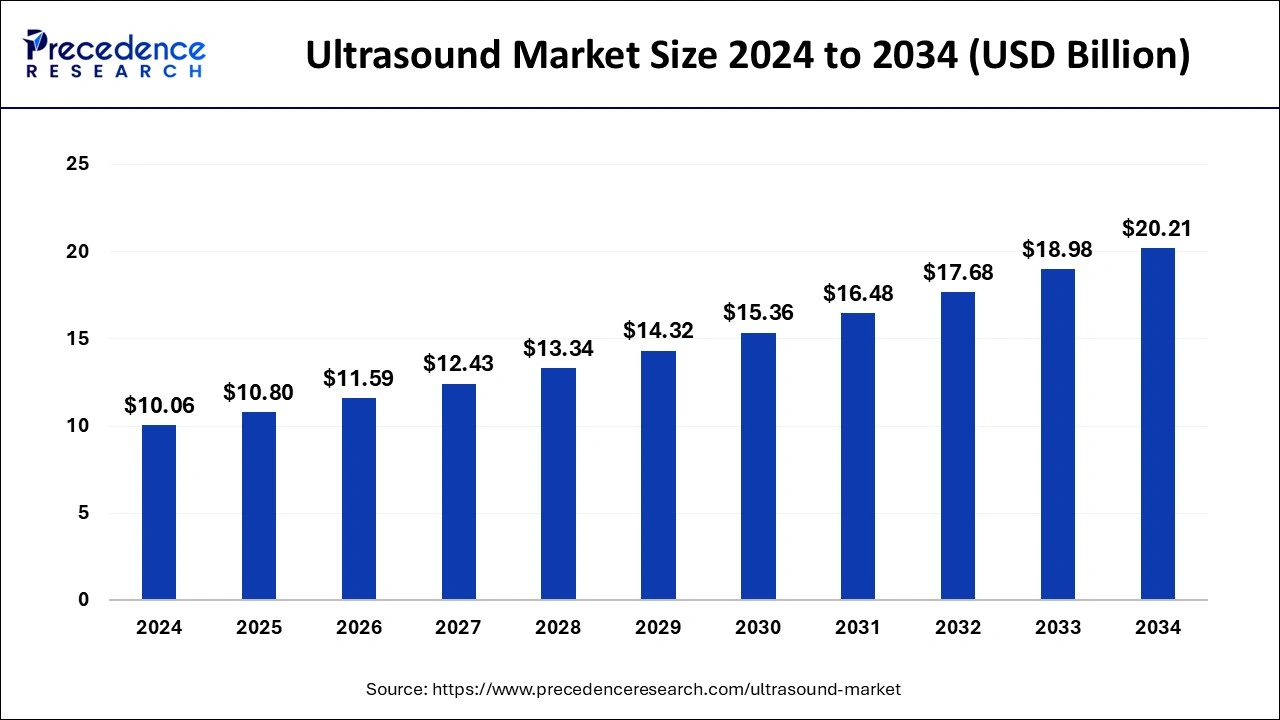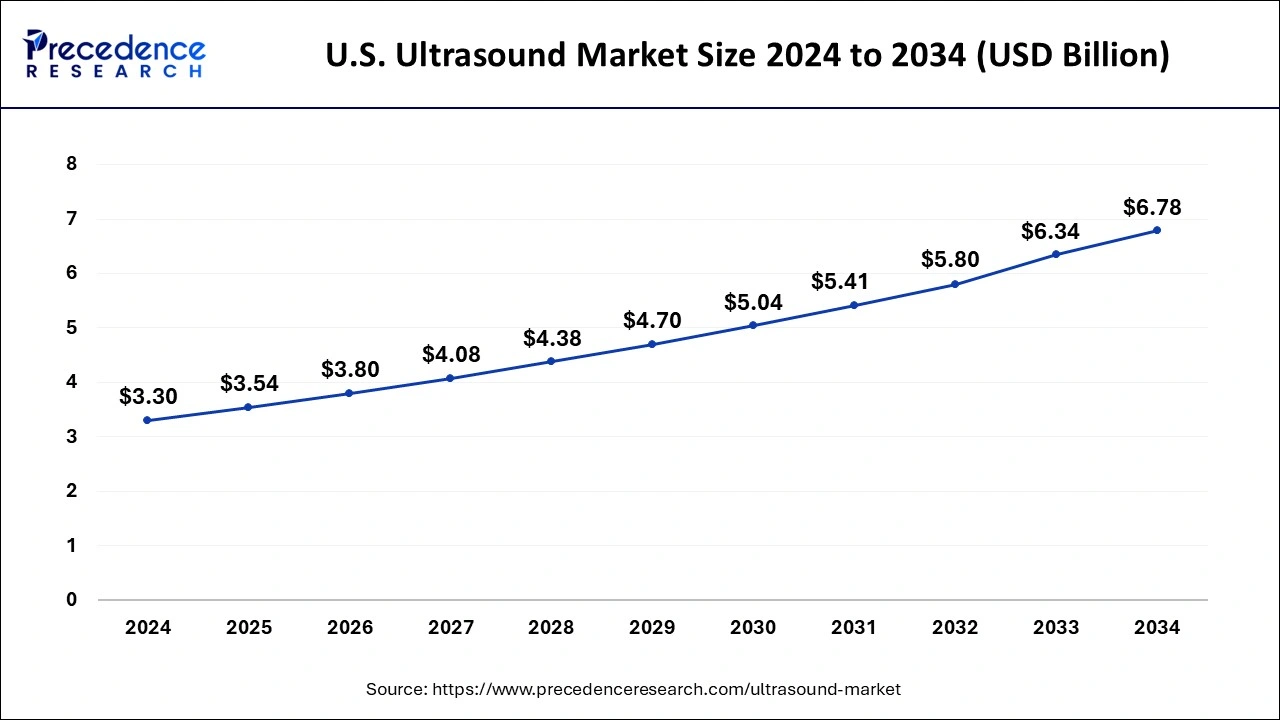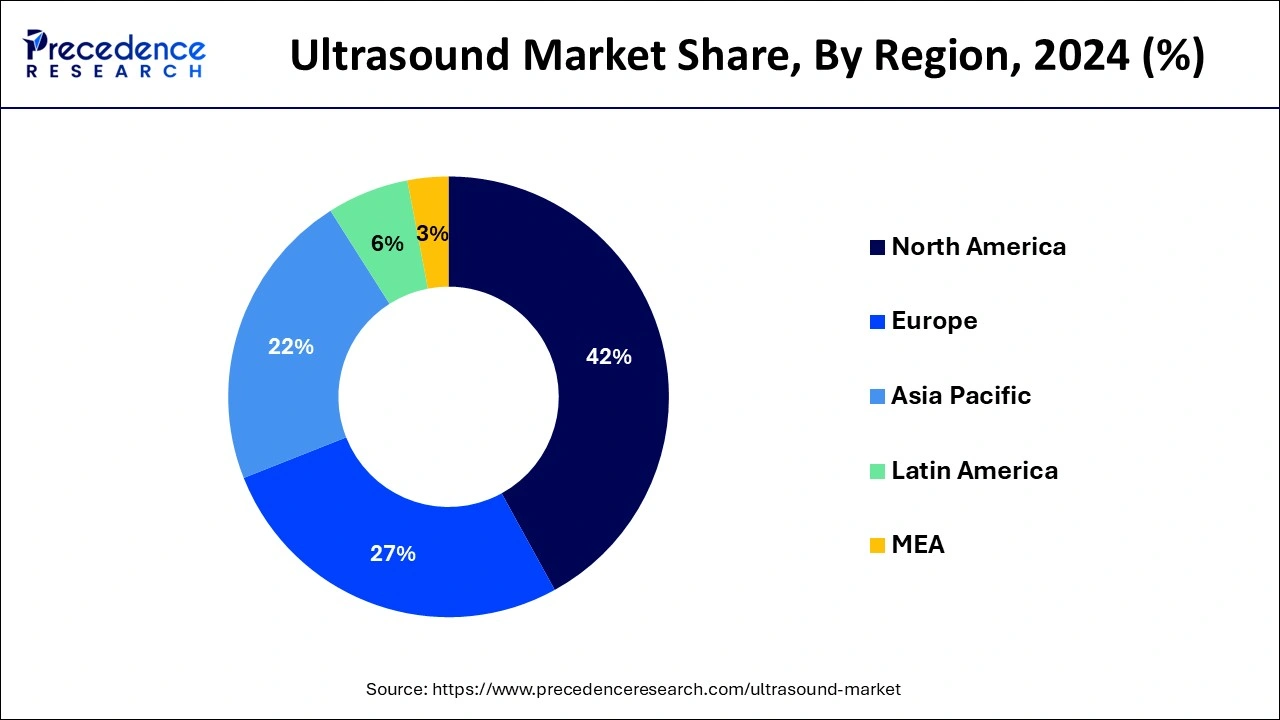April 2025
The global ultrasound market size is accounted at USD 10.80 billion in 2025 and is forecasted to hit around USD 20.21 billion by 2034, representing a CAGR of 7.23% from 2025 to 2034. The North America market size was estimated at USD 4.23 billion in 2024 and is expanding at a CAGR of 7.26% during the forecast period. The market sizing and forecasts are revenue-based (USD Million/Billion), with 2024 as the base year.
The global ultrasound market size was calculated at USD 10.06 billion in 2024 and is predicted to increase from USD 10.80 billion in 2025 to approximately USD 20.21 billion by 2034, expanding at a CAGR of 7.23% from 2025 to 2034. The rise in the number of diagnostic centres and hospitals is driving the growth of the ultrasound market.

The U.S. ultrasound market size was exhibited at USD 3.30 billion in 2024 and is projected to be worth around USD 6.78 billion by 2034, growing at a CAGR of 7.47% from 2025 to 2034.

North America dominated the ultrasound market in 2024. The market growth is generally driven by the rising prevalence of target diseases, the growing trend of cosmetic surgeries, and increased healthcare spending by the private and public sectors. Moreover, new research developments and innovations in the medical field, along with new approvals from the United States Food and Drug Administration and the launch of new products by key market players such as Mindray, Butterfly, GE, Medtronic, Siemens, and others.

Asia-Pacific is expected to be the fastest-growing region during the forecast period. The market in this region is generally driven by the rising prevalence of chronic diseases such as cancer, cardiovascular diseases, and other gastrointestinal disorders. According to the World Health Organisation (WHO), more than 2.2 million new cancer cases and approximately 1.4 million cancer-related deaths in the Southeast Asia Region in 2020. According to a study by Asia Pacific Cohort Studies Collaboration (APCSC), there is an estimated increase of 60% in CVD patients in Asian countries. Also, it is estimated that the total number of hypertension patients in India and China is likely to increase to more than 500 million by the year 2025. Thus, rising cases of cancers and cardiovascular diseases are likely to be diagnosed early for detection and treatment, which increases the demand for ultrasound devices, which is likely to boost the ultrasound market in this region.
In addition, the rise in the geriatric population suffering from chronic diseases in countries such as Japan, India, and China has increased rapidly over time. According to a Journal of Medical Internet Research, 80% of adults above 75 years or over suffered from multiple chronic diseases, and 90% of them suffered from at least one chronic disease. Thus, the rise in the number of geriatric populations suffering from such diseases requires regular checkups to get cured, which drives the demand for ultrasound systems. Also, the rising development in medical sciences and rising demand for portable ultrasound machines, along with the growing adoption of 2D ultrasound imaging, further drive the growth of the ultrasound market.
An ultrasound is a risk-free imaging test of body parts that uses the principle of sound waves. The frequencies of ultrasound sound waves are always greater than 20 kilohertz. It is also known as sonography and is done for detecting the internal body parts of humans. It is mainly done for viewing various reproductive parts, such as the uterus and ovaries, during pregnancy, along with monitoring the infant inside the womb. Sonography is also done to detect gallbladder and appendix-related issues inside the human body. Some ultrasounds are also performed to check the blood flow and tumour treatment.
Nowadays, ultrasounds are also performed in veterinary fields to examine various soft tissues present in the musculoskeletal system of animals. The ultrasound industry has experienced several changes in engineering methods and technological advancement over the past decade. This industry is fragmented, with the presence of several small and big players. The market players are effectively engaged in improving product offerings by exploring acquisitions and government approvals, developing new products, and collaborating to increase their brand demand and attain a greater ultrasound market share.
| Report Coverage | Details |
| Growth Rate from 2025 to 2034 | CAGR of 7.23% |
| Market Size in 2025 | USD 10.80 Billion |
| Market Size in 2024 | USD 10.06 Billion |
| Market Size by 2034 | USD 20.21 Billion |
| Largest Market | North America |
| Base Year | 2024 |
| Forecast Period | 2025 to 2034 |
| Segments Covered | Product, Portability, Application, and End-use |
| Regions Covered | North America, Europe, Asia-Pacific, Latin America, and Middle East & Africa |
Rising number of chronic diseases
The rise in the prevalence of chronic diseases such as arthritis, cancer, Chronic Obstructive Pulmonary Disease (COPD), and others. The prevalence of cancer has increased globally in recent times. The main types of cancer include carcinoma, melanoma, lymphoma, sarcoma, and leukemia. According to WHO, the number of new cancer patients reached 20 million, along with 9.7 million cancer-related deaths in the year 2022. Also, there is a high growth rate in patients suffering from heart disease globally. According to a report published by the World Heart Federation, more than half a billion people across the world were affected by cardiovascular diseases, which accounted for 20.5 million deaths in 2021. Thus, the increasing number of cancer patients and heart patients require early detection for proper treatment, which increases the demand for ultrasound devices, thereby boosting the growth of the ultrasound market.
Stringent government regulations and high cost
The governments of several countries, such as China, Japan, Canada, and others, may not approve some medical equipment due to various reasons such as high risk, negative effects, and other problems. Thus, non-approval of medical equipment, including ultrasound machines, is likely to restrain the growth of the ultrasound market. Also, the initial cost of setting up an ultrasound system is very high, and maintenance charges are rising day by day. Thus, the high cost associated with ultrasound systems is expected to restrain the ultrasound market growth during the forecast period.
Integration of AI in medical equipment
The healthcare sector has experienced several transitions from time to time. There have been several technological developments in this field that can positively impact the healthcare sector. Nowadays, traditional surgeries are being replaced by robotic surgeries so as to get maximum precision and accuracy. The integration of AI in medical instruments such as MRI machines, ultrasound systems, BP machines, and others can result in superior results.
The diagnostic segment held the largest market share in 2024. The segment is observed to sustain the position during the forecast period. This segment is mainly driven by technological advancements such as 2D and 4D imaging and rising adoption of point-of-care ultrasound system (POCUS). Moreover, the growth of this segment can be attributed to the rise in the number of minimally invasive surgeries and growing number of clinal laboratories and hospitals across the globe. According to an article published by the Annals of Medicine and Surgery in October 2021, MIS has replaced the conventional methods of surgical interventions due to rising interest of people towards rapid recoveries, improved survival and fewer complications.
The cart/trolley segment dominated the ultrasound market in 2024. The growth of this segment is mainly driven due to cost-effectiveness and rising demand for ultrasound systems with features such as enhanced picture quality, high grade battery capacity and user-friendly interfaces. Also, several medical device companies such as Medtronic, Hologic, Canon Medical Systems and others are engaged in research and development of Cart/Trolley ultrasound systems that are likely to boost the growth of the global ultrasound market. For instance, recently, Hologic, launched SuperSonic MACH 40 ultrasound system. This is a cart-based ultrasound system that integrates AI and B-mode imaging technology to provide clearer images of cells and other body parts.
The radiology segment dominated the ultrasound market in 2024. This segment is mainly driven by integration of AI in ultrasound systems along with growing cases of cardiac disorders that require proper diagnosis and treatment to get cured. Ultrasound technology is widely used in radiology for diagnostic imaging across various medical specialties, including obstetrics and gynecology, cardiology, oncology, and musculoskeletal imaging. Its versatility makes it an essential tool for radiologists in assessing a wide range of medical conditions. Ultrasound imaging is non-invasive and does not involve ionizing radiation, unlike other imaging modalities such as X-rays and CT scans. This makes it safer for patients, particularly for pregnant women and pediatric patients, and reduces the risk of radiation exposure.
The hospitals segment dominated the ultrasound market in 2024 and the segment is observed to sustain the position during the forecast period. The growth of this segment is mainly driven by growing use of ultrasound devices in hospital settings along with rising number of patients in hospitals suffering from different diseases. Moreover, introduction of portable ultrasound systems in hospitals is expected to fuel the demand for ultrasound devices in OPD and in-patient departments. Furthermore, the increasing investment from public and private entities related to development in healthcare sectors is also expected to foster the growth of the market. Additionally, growing awareness regarding regular healthcare checkups and rising number of accident cases globally has increased the demand for ultrasound devices in hospitals, thereby driving the market growth.
By Product
By Portability
By Application
By End-use
By Geography
For inquiries regarding discounts, bulk purchases, or customization requests, please contact us at sales@precedenceresearch.com
No cookie-cutter, only authentic analysis – take the 1st step to become a Precedence Research client
April 2025
April 2025
May 2025
November 2024